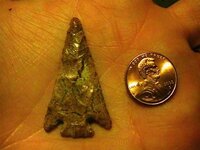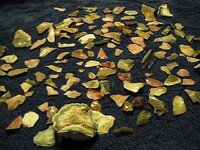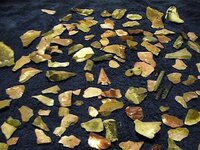sidmind
Full Member
- Nov 10, 2008
- 198
- 8
My wife and I have been wanting to go hunting for some time and finally this last weekend the water had dropped in the River, I had spent several weeks asking people for advice so we went out. When we arrived another couple were already hunting points, and because I had very little clue to what I was doing I asked for some advice, after only 15 minutes of talking and walking with him I looked down and found my first Arrow Head just sitting on top of the ground a few feet from the water. Lucky me!
I am so excited and looking forward to more, anyone have a clue as to which type it is or how much it's worth? not that I plan to sell it.
I have ordered the price guide but it will be a 10-14 days for delivery.

below is just some of the flint and scrapers we found(11-8-2008 and 11-9-2008), along with a few fossils and a Gemstone rock of some sorts.
My wife found most of what you see there, I got lucky on the point, but she seems to have a better eye than I do.


I am so excited and looking forward to more, anyone have a clue as to which type it is or how much it's worth? not that I plan to sell it.
I have ordered the price guide but it will be a 10-14 days for delivery.

below is just some of the flint and scrapers we found(11-8-2008 and 11-9-2008), along with a few fossils and a Gemstone rock of some sorts.
My wife found most of what you see there, I got lucky on the point, but she seems to have a better eye than I do.


Amazon Forum Fav 👍
Upvote
0



 I alway walk back with a pocket full of flakes. Some of the flakes are so pretty I have to pick them up.
I alway walk back with a pocket full of flakes. Some of the flakes are so pretty I have to pick them up. My first point is still my favorite (Molly knows which one I am referring to
My first point is still my favorite (Molly knows which one I am referring to  ) and I have yet to be able to op it. Have fun and post your finds. I cant wait to see them.
) and I have yet to be able to op it. Have fun and post your finds. I cant wait to see them.


